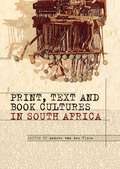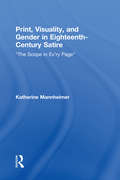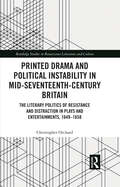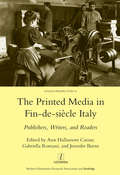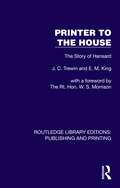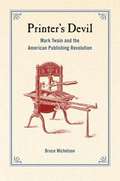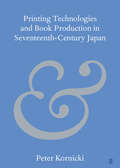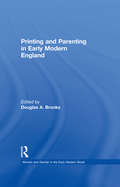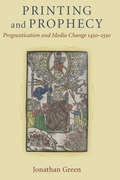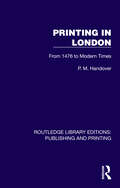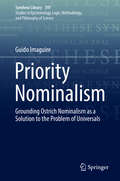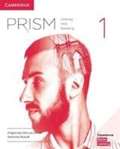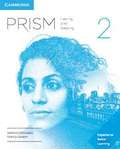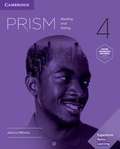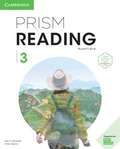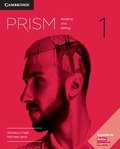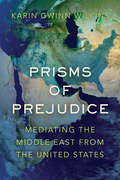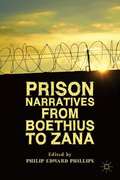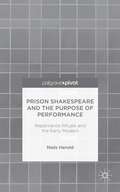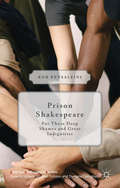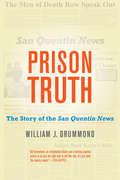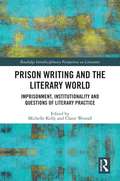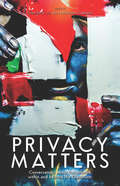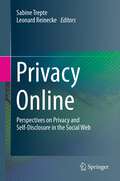- Table View
- List View
Print, Text and Book Cultures in South Africa
by Andrew van VliesAn explanation of the unique role of the book and book collecting in South Africa due to the apartheidThis book explores the power of print and the politics of the book in South Africa from a range of disciplinary perspectives- historical, bibliographic, literary-critical, sociological, and cultural studies. The essays collected here, by leading international scholars, address a range of topics as varied as: the role of print cultures in contests over the nature of the colonial public sphere in the nineteenth century; orthography; iimbongi, orature and the canon; book- collecting and libraries; print and transnationalism; Indian Ocean cosmopolitanisms; books in war; how the fates of South African texts, locally and globally, have been affected by their material instantiations; photocomics and other ephemera; censorship, during and after apartheid; books about art and books as art; local academic publishing; and the challenge of 'book history' for literary and cultural criticism in contemporary South Africa.
Print, Visuality, and Gender in Eighteenth-Century Satire: “The Scope in Ev’ry Page” (Routledge Studies in Eighteenth-Century Literature)
by Katherine MannheimerThis study interprets eighteenth-century satire’s famous typographical obsession as a fraught response to the Enlightenment’s "ocularcentric" epistemological paradigms, as well as to a print-cultural moment identified by book-historians as increasingly "visual" — a moment at which widespread attention was being paid, for the first time, to format, layout, and eye-catching advertising strategies. On the one hand, the Augustans were convinced of the ability of their elaborately printed texts to function as a kind of optical machinery rivaling that of the New Science, enhancing readers’ physical but also moral vision. On the other hand, they feared that an overly scrutinizing gaze might undermine the viewer’s natural faculty for candor and sympathy, delight and desire. In readings of Pope, Swift, and Montagu, Mannheimer shows how this distrust of the empirical gaze led to a reconsideration of the ethics, and most specifically the gender politics, of ocularcentrism. Whereas Montagu effected this reconsideration by directly satirizing both the era’s faith in the visual and its attendant publishing strategies, Pope and Swift pursued their critique via print itself: thus whether via facing-page translations, fictional editors, or disingenuous footnotes, these writers sought to ensure that typography never became either a mere tool of (or target for) the objectifying gaze, but rather that it remained a dynamic and interactive medium by which readers could learn both to see and to see themselves seeing.
Printed Drama and Political Instability in Mid-Seventeenth Century Britain: The Literary Politics of Resistance and Distraction in Plays and Entertainments from 1649-1658 (Routledge Studies in Renaissance Literature and Culture)
by Christopher OrchardPrinted Drama and Political Instability in Mid-Seventeenth Century Britain: The Literary Politics of Resistance and Distraction in Plays and Entertainments from 1649-1658 describes the function of printed drama in 1650s Britain. After the regicide of 1649, printed plays could be interpreted by Royalist readers as texts of resistance to the republic and protectoral governments respectively. However, there were often discrepancies between the aspirational content of these plays and the realities facing a Royalist party who had been defeated in the civil wars. Similarly, plays with a classically republican Roman setting failed to offer a successful model for the new republic. Consequently, writers who supported the new republic and, eventually, Cromwell’s protectoral government, proposed entertainments, based around the concept of the sublime, whose purpose was affect: that is, creating political amnesia in the audience, thereby nullifying any political dissatisfaction with a non-monarchical form of government. This volume will appeal to students and scholars of seventeenth century literature, and of the political history of 1640s and 1650s Britain.
Printed Media in Fin-de-siecle Italy: Publishers, Writers, and Readers
by Ann Hallamore Caesar"The Unification of Italy in 1870 heralded a period of unprecedented change. While successive Liberal governments pursued imperial ventures and took Italy into World War One on the Allied side, on the domestic front technological advance, the creation of a national transport network, the expansion of state education, internal migration to cities and the rise of political associations all contributed to the rapid expansion of the print industry and the development of new and highly diversified reading publics. Drawing on publishers'archives, letters, diaries, and printed material, this book provide the most up-to-date research into the printed media - books, magazines and journals - in Italy between 1870 and 1914. With essays on publishers and reading communities, the professionalization of the role of journalist and writer, children's literature, book illustrations, and printed media in colonial territories among others, this book is intended for those with interests in cultural production and consumption and questions of nation-formation and nationhood in and outside Italy. With the contributions: Ann Hallamore Caesar, Gabriella Romani- Introduction John Davis- Media, Markets and Modernity: The Italian Case, 1870-1915 Maria Grazia Lolla- Reader/Power: The Politics and Poetics of Reading in Post-Unification Italy Joseph Luzzi- Verga Economicus: Language, Money, and Identity in I Malavoglia and Mastro-don Gesualdo Olivia Santovetti- The Cliche of the Romantic Female Reader and the Paradox of Novelistic Illusion: Federico De Roberto's L'Illusione (1891) Francesca Billiani- Intellettuali militanti, funzionari e tecnologici, etica ed estetica in tre riviste fiorentine d'inizio secolo: Il Regno, La Voce, e Lacerba (1903-1914) Luca Somigli- Towards a Literary Modernity all'italiana: A Note on F. T. Marinetti's Poesia Silvia Valisa- Casa editrice Sonzogno. Mediazione culturale, circuiti del sapere ed innovazione tecnologica nell'Italia unificata (1861-1900) Matteo Salvadore- At the Borders of 'Dark Africa': Italian Expeditions to Ethiopia and the Bollettino della Societa Geografica Italiana, 1867-1887 Ombretta Frau- L'editore delle signore: Licinio Cappelli e la narrativa femminile fra Otto e Novecento Cristina Gragnani- Il lettore in copertina. Flirt rivista di splendore e declino (Primo tempo: 1897-1902) Fiorenza Weinapple- Abbiamo fatto l'Italia. Adesso si tratta di fare gli Italiani. Il Programma di educazione nazionale del Secolo XX Fabio Gadducci, Mirko Tavosanis- Printers, Poets, Publishers and Painters: The First Years of the Giornale per i bambini John P. Welle- The Magic Lantern, the Illustrated Book, and the Beginnings of the Culture Industry: Intermediality in Carlo Collodi's La lanterna magica di Giannettino"
Printer to the House: The Story of Hansard (Routledge Library Editions: Publishing and Printing)
by J. C. Trewin E. M. KingEveryone knows the name of Hansard, the famous record of Parliamentary proceedings. Very few people know how it began. Originally published in 1952, here was for the first time, the authoritative history of the Hansard family and of its work, for nearly 100 years, as Parliamentary printers in charge of the Journals of the House of Commons and of the full record of debates that still bears the family name. Full of surprising and important detail, it was written largely from unpublished papers, letters, and the manuscript diaries of Luke Graves Hansard, son of old Luke, founder of the printing dynasty.Luke Hansard (1752–1828), a young man from Norwich, succeeded his partner Henry Hughs as Printer to the House. His name was known to all the politicians and many of the authors of his day, for he was a remarkable character, vigorous and forthright; and this book contains, among much else, a transcript of the brief autobiography he wrote in old age. He and his descendants printed the Journals of the House of Commons until 1890. His eldest son Thomas Curson Hansard, in partnership with William Cobbett, began to print the Parliamentary Debates early in the nineteenth century, and later became sole proprietor. His descendants carried on the business until 1889.This is an authoritative and extremely readable book which will be of value to all students of politics wherever the name Hansard is known – and there are “Hansards” in Australia, Canada and many other parts of the Commonwealth and Empire as well as in Great Britain. It touches on constitutional questions of great importance and explores some fascinating byways of parliamentary history.
Printer's Devil: Mark Twain and the American Publishing Revolution
by Bruce MichelsonThis book speaks about Mark Twain and the history of print culture in America.
Printers Without Borders
by A. E. B. ColdironThis innovative study shows how printing and translation transformed English literary culture in the Renaissance. Focusing on the century after Caxton brought the press to England in 1476, Coldiron illustrates the foundational place of foreign, especially French language, materials. The book reveals unexpected foreign connections between works as different as Caxton's first printed translations, several editions of Book of the Courtier, sixteenth-century multilingual poetry, and a royal Armada broadside. Demonstrating a new way of writing literary history beyond source-influence models, the author treats the patterns and processes of translation and printing as co-transformations. This provocative book will interest scholars and advanced students of book history, translation studies, comparative literature and Renaissance literature.
Printing Technologies and Book Production in Seventeenth-Century Japan (Elements in Publishing and Book Culture)
by Peter KornickiThis Element first sets the history of printing in Japan in its East Asian context, showing how developments in China, Korea and elsewhere had an impact upon Japan. It then undertakes a re-examination of printing in seventeenth-century Japan and in particular explores the reasons why Japanese printers abandoned typography less than fifty years after it was introduced. This is a question that has often been posed but never satisfactorily answered, but this Element takes a new approach, focusing on two popular medical texts that were first printed typographically and then xylographically. The argument presented here is that the glosses relied upon by Japanese readers could be much more easily be provided when printing xylographically: since from the early seventeenth century onwards printed books customarily included glosses for the convenience of readers, this was surely the reason for the abandonment of typography.
Printing and Parenting in Early Modern England (Women and Gender in the Early Modern World)
by Douglas A. BrooksThe relation between procreation and authorship, between reproduction and publication, has a long history - indeed, that relationship may well be the very foundation of history itself. The essays in this volume bring into focus a remarkably important and complex phase of this long history. In this volume, some of the most renowned scholars in the field persuasively demonstrate that during the early modern period, the awkward, incomplete transition from manuscript to print brought on by the invention of the printing press temporarily exposed and disturbed the epistemic foundations of English culture. As a result of this cultural upheaval, the discursive field of parenting was profoundly transformed. Through an examination of the literature of the period, this volume illuminates how many important conceptual systems related to gender, sexuality, human reproduction, legitimacy, maternity, kinship, paternity, dynasty, inheritance, and patriarchal authority came to be grounded in a range of anxieties and concerns directly linked to an emergent publishing industry and book trade. In exploring a wide spectrum of historical and cultural artifacts produced during the convergence of human and mechanical reproduction, of parenting and printing, these essays necessarily bring together two of the most vital critical paradigms available to scholars today: gender studies and the history of the book. Not only does this rare interdisciplinary coupling generate fresh and exciting insights into the literary and cultural production of the early modern period but it also greatly enriches the two critical paradigms themselves.
Printing and Prophecy: Prognostication and Media Change, 1450-1550
by Jonathan GreenPrinting and Prophecy: Prognostication and Media Change 1450-1550examines prognostic traditions and late medieval prophetic texts in the first century of printing and their effect on the new medium of print. The many prophetic and prognostic works that followed Europe's earliest known printed book---not the Gutenberg Bible, but theSibyl's Prophecy, printed by Gutenberg two years earlier and known today only from a single page---over the next century were perennial best sellers for many printers, and they provide the modern observer with a unique way to study the history and inner workings of the print medium. The very popularity of these works, often published as affordable booklets, raised fears of social unrest. Printers therefore had to meet customer demand while at the same time channeling readers' reactions along approved paths. Authors were packaged---and packaged themselves---in word and image to respond to the tension, while leading figures of early modern culture such as Paracelsus, Martin Luther, and Sebastian Brant used printed prophecies for their own purposes in a rapidly changing society. Based on a wide reading of many sources,Printing and Prophecycontributes to the study of early modern literature, including how print changed the relationship among authors, readers, and texts. The prophetic and astrological texts the book examines document changes in early modern society that are particularly relevant to German studies and are key texts for understanding the development of science, religion, and popular culture in the early modern period. By combining the methods of cultural studies and book history, this volume brings a new perspective to the study of Gutenberg and later printers.
Printing in London: From 1476 to Modern Times (Routledge Library Editions: Publishing and Printing)
by P. M. HandoverOriginally published in 1960, the early history of news-gathering, of advertisement blocks and displayed advertising, of women’s magazine, are among the varied aspects of the London printing trade discussed in this book. Separate chapters are devoted to jobbing printing and the controversial, competitive Bible patent. The considerable technical information includes detailed descriptions of nineteenth-century presses.Besides an account of the struggle for power in the Stationers’ Company at certain periods, the livelier – and often more ruthless – personalities in the London trade, such as John Wolfe, Robert Barker I, Miles Flesher, Henry Hills and John Bell are vigorously described.Every section is generously illustrated in line and half-tone with material much of which was previously unreproduced.The easy style and wide range of Printing in London will rouse the interest of both the specialist – in advertising, in libraries and in the trade itself – and of the general reader who wants to know more about the history of printing.
Priority Nominalism: Grounding Ostrich Nominalism as a Solution to the Problem of Universals (Synthese Library #397)
by Guido ImaguireThis monograph details a new solution to an old problem of metaphysics. It presents an improved version of Ostrich Nominalism to solve the Problem of Universals. This innovative approach allows one to resolve the different formulations of the Problem, which represents an important meta-metaphysical achievement.In order to accomplish this ambitious task, the author appeals to the notion and logic of ontological grounding. Instead of defending Quine’s original principle of ontological commitment, he proposes the principle of grounded ontological commitment. This represents an entirely new application of grounding.Some metaphysicians regard Ostrich Nominalism as a rejection of the problem rather than a proper solution to it. To counter this, the author presents solutions for each of the formulations. These include: the problem of predication, the problem of abstract reference, and the One Over Many as well as the Many Over One and the Similar but Different variants.This book will appeal to anyone interested in contemporary metaphysics. It will also serve as an ideal resource to scholars working on the history of philosophy. Many will recognize in the solution insights resembling those of traditional philosophers, especially of the Middle Ages.
Prism Level 1: Listening and Speaking
by Angela Blackwell Stephanie Dimond-Bayir Kimberly Russell Carolyn FloresPrism' is a five-level (A1 to C1), American English paired-skills course (reading/writing and listening/speaking), created for students who need to develop a range of academic skills. Prism helps students by creating activities such as categorizing information, comparing data, selecting the best solution to a problem, and developing arguments for a discussion or presentation. Students need to be able to recall information, comprehend it, and see its use in new contexts. Prism develops these skills through exercises such as taking notes, mining notes for specific data, demonstrating comprehension, and distilling information from charts.
Prism Level 2: Listening and Speaking
by Angela Blackwell Sabina Ostrowska Nancy Jordan Janet GokayPaired skills course focusing on critical thinking, academic skills, and language students need most. Prism is a five-level (A1 to C1), American English paired-skills course (Reading/Writing and Listening/Speaking), created for students who need to develop a range of academic skills. This Level 2 (B1) Listening and Speaking Student's Book prepares students for college classes by developing their listening, speaking, critical thinking, and pronunciation skills, including pronunciation for listening. Special sections teach how to be a successful college student, and the accompanying video program sets the stage for each unit's topic. Inside the book is a single-use code for the online workbook. This provides automatically graded extra practice and works on PCs and Macs.
Prism Level 4 Student's Book With Online Workbook Reading And Writing (Prism)
by Jessica Williams Wendy Asplin Christina CavagePaired skills course focusing on critical thinking, academic skills, and language students need most. Prism is a five-level (A1 to C1), American English paired-skills course (Reading/Writing and Listening/Speaking), created for students who need to develop a range of academic skills. This Level 4 (C1) Reading and Writing Student’s Book prepares students for college classes by developing their critical thinking, reading and writing skills, including grammar for writing. Special sections teach how to be a successful college student, and the accompanying video
Prism Reading Level 3 Student's Book With Online Workbook
by Alan S. Kennedy Chris SowtonPrism Reading Level 3 has 8 units to develop vocabulary, academic, and critical thinking skills. Students experience topics through fascinating readings in a wide variety of genres and formats to become familiar with material they might face in or outside the college classroom. Each book includes a single-use code to access the Online Workbook that has one new reading per unit, extra practice to further improve reading, vocabulary, and language development. Other resources include videos and recordings of readings. Activities have automated feedback to help with learner autonomy, and for teachers to spend less time grading and more time teaching.
Prism: Level 1 Student's Book With Online Workbook Reading And Writing (Prism)
by Wendy Asplin Carolyn Flores Richard O'Neill Michele LewisPrism Level 1 Student's Book Reading and Writing 9
Prisms of Prejudice: Mediating the Middle East from the United States
by Karin Gwinn WilkinsMedia do not reflect: media refract. In the United States, established and enduring prisms of prejudice about the projected "Middle East" are mediated through popular culture, broadcast news, government mission statements and official maps. This mediation serves to assert political boundaries and construct the United States as heroic against a villainous or victimized Middle East. These problematic maps and narratives are persistent over time and prevalent across genre, with clear consequences evidenced by the rise in discriminatory sentiments in the US population and experiences of harm in US Arab and Muslim communities. Exploring a wide range of media, Karin Gwinn Wilkins illuminates the shape and scope of these narratives and explores ways to counter these prisms of prejudice through informed and engaged strategic intervention in critical communication literacy.
Prison Narratives from Boethius to Zana
by Philip Edward PhillipsPrison Narratives from Boethius to Zana critically examines selected works of writers, from the sixth century to the twenty-first century, who were imprisoned for their beliefs. Chapters explore figures' lives, provide close analyses of their works, and offer contextualization of their prison writings.
Prison Shakespeare and the Purpose of Performance: Repentance Rituals and the Early Modern
by Niels HeroldOver the last decade a number of prison theatre programs have developed to rehabilitate inmates by having them perform Shakespearean adaptations. While twentieth and twenty-first century ideas about theatre as therapy, political resistance, and popular education hold sway for many programs, this book focuses on how prison theatre today reveals certain elements of the early modern theatre that were themselves responses to cataclysmic changes in theological doctrine and religious practice. Herold reads the Shakespearean theatre at once historically and forward ("presentising"). He examines the precise dramaturgical and ideological elements of this historical theatre that are today conducive to the remarkable rehabilitative success of prison theatre programs like Shakespeare Behind Bars.
Prison Shakespeare: For These Deep Shames and Great Indignities (Palgrave Shakespeare Studies)
by Rob PensalfiniThis book explores the development of the global phenomenon of Prison Shakespeare, from its emergence in the 1980s to the present day. It provides a succinct history of the phenomenon and its spread before going on to explore one case study the Queensland Shakespeare Ensemble's (Australia) Shakespeare Prison Project in detail. The book then analyses the phenomenon from a number of perspectives, and evaluates a number of claims made about the outcomes of such programs, particularly as they relate to offender health and behaviour. Unlike previous works on the topic, which are largely individual case studies, this book focuses not only on Prison Shakespeare's impact on the prisoners who directly participate, but also on prison culture and on broader social attitudes towards both prisoners and Shakespeare.
Prison Truth: The Story of the San Quentin News
by William J. DrummondSan Quentin State Prison, California’s oldest prison and the nation’s largest, is notorious for once holding America’s most dangerous prisoners. But in 2008, the Bastille-by-the-Bay became a beacon for rehabilitation through the prisoner-run newspaper the San Quentin News.Prison Truth tells the story of how prisoners, many serving life terms, transformed the prison climate from what Johnny Cash called a living hell to an environment that fostered positive change in inmates’ lives. Award-winning journalist William J. Drummond takes us behind bars, introducing us to Arnulfo García, the visionary prisoner who led the revival of the newspaper. Drummond describes how the San Quentin News, after a twenty-year shutdown, was recalled to life under an enlightened warden and the small group of local retired newspaper veterans serving as advisers, which Drummond joined in 2012. Sharing how officials cautiously and often unwittingly allowed the newspaper to tell the stories of the incarcerated, Prison Truth illustrates the power of prison media to humanize the experiences of people inside penitentiary walls and to forge alliances with social justice networks seeking reform.
Prison Writing and the Literary World: Imprisonment, Institutionality and Questions of Literary Practice (Routledge Interdisciplinary Perspectives on Literature)
by Michelle Kelly and Claire WestallPrison Writing and the Literary World tackles international prison writingand writing about imprisonment in relation to questions of literary representationand formal aesthetics, the “value” or “values” of literature,textual censorship and circulation, institutional networks and literary-criticalmethodologies. It offers scholarly essays exploring prison writingin relation to wartime internment, political imprisonment, resistance andindependence creation, regimes of terror, and personal narratives of developmentand awakening that grapple with race, class and gender. Cuttingacross geospatial divides while drawing on nation- and region-specific expertise,it asks readers to connect the questions, examples and challengesarising from prison writing and writing about imprisonment within theUK and the USA, but also across continental Europe, Stalinist Russia, theAmericas, Africa and the Middle East. It also includes critical reflectionpieces from authors, editors, educators and theatre practitioners with experienceof the fraught, testing and potentially inspiring links between prisonand the literary world.
Privacy Matters: Conversations about Surveillance within and beyond the Classroom
by Estee Beck Les HutchinsonPrivacy Matters examines how communications and writing educators, administrators, technological resource coordinators, and scholars can address the ways surveillance and privacy affect student and faculty composing, configure identity formation, and subvert the surveillance state. This collection offers practical analyses of surveillance and privacy as they occur within classrooms and communities. Organized by themes—surveillance and classrooms, surveillance and bodies, surveillance and culture—Privacy Matters provides writing, rhetoric, and communication scholars and teachers with specific approaches, methods, inquiries, and examinations into the impact tracking and monitoring has upon people’s habits, bodies, and lived experiences. While each chapter contributes a new perspective in the discipline and beyond, Privacy Matters affirms that these analyses remain inconclusive. This collection is a call for scholars, researchers, activists, and educators within rhetoric and composition to continue the scholarly conversation because privacy matters to all of us. Contributors: Christina Cedillo, Jenae Cohn, Dànielle Nicole DeVoss, Dustin Edwards, Norah Fahim, Ann Hill Duin, Gavin P. Johnson, John Peterson, Santos Ramos, Colleen A. Reilly, Jennifer Roth Miller, Jason Tham, Stephanie Vie
Privacy Online
by Sabine Trepte Leonard ReineckeCommunications and personal information that are posted online are usually accessible to a vast number of people. Yet when personal data exist online, they may be searched, reproduced and mined by advertisers, merchants, service providers or even stalkers. Many users know what may happen to their information, while at the same time they act as though their data are private or intimate. They expect their privacy will not be infringed while they willingly share personal information with the world via social network sites, blogs, and in online communities. The chapters collected by Trepte and Reinecke address questions arising from this disparity that has often been referred to as the privacy paradox. Works by renowned researchers from various disciplines including psychology, communication, sociology, and information science, offer new theoretical models on the functioning of online intimacy and public accessibility, and propose novel ideas on the how and why of online privacy. The contributing authors offer intriguing solutions for some of the most pressing issues and problems in the field of online privacy. They investigate how users abandon privacy to enhance social capital and to generate different kinds of benefits. They argue that trust and authenticity characterize the uses of social network sites. They explore how privacy needs affect users' virtual identities. Ethical issues of privacy online are discussed as well as its gratifications and users' concerns. The contributors of this volume focus on the privacy needs and behaviors of a variety of different groups of social media users such as young adults, older users, and genders. They also examine privacy in the context of particular online services such as social network sites, mobile internet access, online journalism, blogs, and micro-blogs. In sum, this book offers researchers and students working on issues related to internet communication not only a thorough and up-to-date treatment of online privacy and the social web. It also presents a glimpse of the future by exploring emergent issues concerning new technological applications and by suggesting theory-based research agendas that can guide inquiry beyond the current forms of social technologies.
